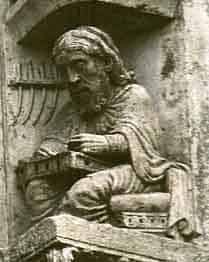This episode of CS is provocatively titled “The Lapsed Dance.”
In the 4th episode titled “Martyrs”, we examined the persecution Christians faced at the hands of the Roman authorities. We noted that persecution, while at times fierce, wasn’t one, long campaign of terror that lasted for a couple centuries. It tended to be spasmodic & regional, based on the whim of the current emperor, enforced in spotty fashion by governors who either agreed or disagreed with the official policy from far-away Rome. There were a couple seasons of Empire-wide persecution in the 3rd C that proved to be the most intense.
Following Trajan’s more even-handed attempt to deal with the problem of the Christians in the early 2nd C, 2 Emperors followed a more rigorous campaign of persecution & pressed its application to the borders of the Empire. In the mid to late 3rd C, Decius & Diocletian considered Christianity a dangerous threat. Their reasons for opposing the Faith were several but looming large was the concern Christianity would weaken the Army, desperately needed to protect the borders being harassed by barbarians. Also, die-hard pagans claimed the old gods who’d overseen Rome’s rise to greatness were angry so many of their worshippers had turned to the new Faith. They warned disaster loomed; the only way to stay it was to appease the wrath of the gods by slaking it with Christian blood.
To this end, some Emperors renewed an old practice: Emperor worship. While the details of this practice varied from time to time & place to place, the basic routine went like this . . .
Once every so many years, the residents of a city had to appear in the public square, where they ascended a raised platform, picked up a pinch of incense, dropped it on some hot coals and announced, “Caesar is Lord.” The exact words of the oath varied depending on who was sitting on the throne. But the point was to honor the reigning Roman Emperor as a deity, minor as that deity might be in the pagan pantheon. While pagans who already recognized a plethora of gods had no problem adding one more to the list, Christians owned a fierce repulsion to confessing anyone other than Jesus Christ as Lord. They simply couldn’t do it. As the pagan left the dais after going through this little rite, he was handed a libelli – a certificate proving his loyalty. He kept that certificate as proof of loyalty, producing it whenever an authority asked him to show his compliance with Rome’s decree. In this manner, the Christians were marked out; they had no libelli.
Now, as can be imagined, this challenge led to some memorable martyrdoms, especially in North Africa where Christianity flourished. It also led to one of the biggest controversies the Church had yet faced.
Some Christians, under the threat of death, capitulated to the pressure, burned the incense & spoke fealty to Caesar. They took the libelli and went about their business. Once the Emperor Decius was gone and persecution eased, these capitulators repented their weakness and applied for readmission to the Church. The challenge for church leaders was = What was to be done with these “lapsed” members, as they were called?
Some advocated their re-admission to the felloowship pending a review of their specific case by the local elders. Others, led by a church leader named Novatian, argued vehemently for their exclusion. For Novatian and his supporters, there was no room for any kind of negotiation. The lapsed were to be barred from fellowship. The controversy between the Novatianists and the majority of churches which by that time had made the church at Rome their unofficial headquarters became so great, it seemed there was only one way to solve it. The Novatianists were declared heretical by the majority and put outside the Communion of Saints.
The Novatianist controversy flared up again following the last great persecution under the Emperor Diocletian. This time it went by the name of Donatism.
During the Diocletian persecution, in order to avoid becoming martyrs, some Church leaders had not only submitted to Caesar worship, they’d surrendered sacred texts to imperial authorities, and, shamefully ratted out other believers. Such lapsed leaders were called “traditores” meaning, those who surrender. One of these traditores was Caecilian, also known as Cyprian. Cyprian hadn’t capitulated and worshipped Caesar, but he did go into hiding when the edict reached Carthage where he was bishop. His critics said he was no better than those who lapsed by this desertion of his post. When the persecution lifted, he wanted to returned to his position. The Church at Carthage was the lead church of all North Africa, a region with a large population of Christians. The Novatianist-leanings of the previous generation were most strong there and were renewed at this time, sparked by the re-installation of Cyprian. Those who refused to accept him, selected their own leader in an elder named Majorinus, whom they made a rival bishop to Cyprian. Majorinus died shortly after being consecrated. He was replaced by Donatus Magnus who advocated the same path of rejecting traditores from church leadership.
The Donatist Controversy is important because what was at stake was the Christian concept of forgiveness and reconciliation. Was the act of saying “Caesar is Lord” while burning incense to an image of the Emperor an act of idolatry that marked one as apostate? And was such a coerced act something from which there was no repentance?
Some said the betrayal by lapsed believers was a renouncing of Christ that condemned them to hell. Others said while some believers became martyrs and their faith was exemplary, those who gave in to the threat of death could not be held responsible and could be re-admitted to the fold, if they showed proper repentance. But such returned believers could not serve in any capacity of leadership in the church. Some held a view of reconciliation so far-reaching, they said even pastors who lapsed could be restored to their positions.
What emerged during this debate was the importance of baptism.
In the Books of Acts, baptism appears to have been used by the Apostles as the means by which believers identified their faith in Christ and their participation in the Community of Faith. On the Day of Pentecost, Peter called for new converts to be baptized immediately. Philip led the Ethiopian eunuch in immediate baptism. Baptism at the moment of conversion seems to be the NT pattern & the practice of the Apostolic Church.
But at some point, church leaders began delaying baptism, calling for converts to have a time of learning before being officially welcomed into the church. The reason for this delay is uncertain, but may have come as a result of seeing that some supposed converts didn’t follow through on their commitment. They fell away after a short time. By delaying baptism and preceding it with a period of instruction, it gave the convert a time to prove the genuineness of their conversion.
While conversion was a work of the Spirit in the human heart, baptism was seen as the way someone made a public profession of faith and ushered them into the Community of Christ. So baptism became a kind of definitive line in the sand. It was thought that if someone renounced Christ AFTER being baptized, they were an apostate to whom repentance was now impossible.
And as might be suspected, different regions understood all this this differently. Some held that to go apostate meant that person had forfeited salvation and was destined for hell. Other’s held that a seeming-apostate was able to repent & return to grace, but their renouncing of the Lord meant their being forever excluded from fellowship. So, they could be saved, but were barred from attending church & taking Communion.
Another position said if someone did repent of what had earlier appeared to be a renouncing of Christ, it was evidence they hadn’t really gone apostate because if they had they wouldn’t repent. Therefore, repentance and the demonstration of a desire to return to God’s grace were evidence of salvation and for that reason the repentant ought to be readmitted to fellowship.
So à the timing of baptism became a major issue once persecution broke out in a threat of martyrdom. Baptism was delayed even longer than it had been because of the line it was thought to have crossed. If a Christian caved during persecution and took a libelli before they’d been baptized, returning to fellowship would be easier. But if he/she lapsed after baptism then returning was more difficult, especially among groups like the Novatians & Donatists.
As we’ll see later, this issue of the timing of baptism extended beyond the time of Imperial persecutions. When the Church began to invest certain sins with greater moral weight and consequence, many delayed baptism lest they commit a major sin after baptism and so incur greater judgment.
For now, let’s return to the Donatist Controversy. Donatus and his followers held the view that pastors and elders who’d lapsed during the Diocletian persecutions were forever barred from leading the Church. Maybe they could be restored to fellowship but being a leader in the Church was out of the question. The majority view was that lapsed leaders could indeed be restored. As you might imagine, the debate was fierce. Many towns were divided between Donatist and non-Donatist congregations. The Donatists were particularly strong in North Africa while the Church at Rome led the non-Donatists who prevailed in Europe.
The Controversy raged for a hundred years & became one of the more contentious issues the Church had to deal with during the 3rd & 4th Cs.
What made the Donatist Controversy such a particularly heated topic was the great admiration believers held for the martyrs who’d maintained their faith & confession of Christ even at the cost of their lives. The question was, how could they be held in such high regard when those who lapsed could be so easily restored to fellowship? Were in fact the martyrs foolish to cast away their lives when a little negotiation & capitulation could have saved them?
No, martyrdom was a baptism by blood considered the utmost glory a believer could attain to. A careful record of the martyrs was kept; the days of their martyrdom celebrated each year. And with each celebration, their stories grew. Their failings were edited out and their reputation embellished until they took on a decidedly “other-worldly” quality. The martyrs were quickly morphing into “saints” – Early Christian super-heroes.
The idea began to develop in North Africa where there had been so many notable martyrdoms, that their exceptional courage achieved a kind of special grace from God that could be turned to other purposes; like, What? Well, how about we use it to forgive the sins of others? Sins like those who’d lapsed. Yeah, that’s it. The righteousness of the martyrs who’d died rather than recant was so great, it made a reserve of grace those who’d avoided martyrdom could draw from! How convenient.
Some bishops thought this a grand idea. Others opposed it, but wanting to find some means by which the lapsed could be returned to fellowship, they devised various means and forms of penance, by which repentant lapsi could demonstrate the sincerity of their desire to return to the fold.
Cyprian, the bishop of Carthage mentioned before, devised a system to allow the lapsed to be reconciled to the Church. He said that simple repentance was enough for those who’d sacrificed to the Emperor after severe torture. But those who’d caved at the mere suggestion of pain had to submit to a penance of punishments. His plan won widespread approval and the Church created a system of penance based on the severity of the guilt of the lapsed. Bishops met with repentant lapsi & prescribed their penance like spiritual doctors dispensing medicine. If and when the penitent successfully jumped thru the prescribed hoops, he/she was allowed to return to fellowship and most importantly, to partake of the Lord’s Table.
While this system of penance was proposed and installed in various places, other regions rejected it as contrary to the character of grace found in the NT. And while it went into general disuse when official persecution ended in the 4th C, the doctrinal foundation was laid for the later system of penance and the Treasury of Merit that would be practiced under the title of Indulgences.
But all that is for a much later episode . . .
Many thanks to those who’ve subscribed to CS and told others about the podcast.
If you haven’t done so yet, drop by the FB page and let us know where you live. The CS family stretches literally around the world.
If you use iTunes as your podcast portal, please think about writing a review. That’s THE most important way to get the word out about the podcast.
While CS is free, we have had to include a donate feature as the costs of hosting the site have gone up.
Lastly, I’m quite stoked to announce CS is now appearing in Spanish.
You can fain all the information you want to follow up on all this at the website – sanctorum.us.






Really helped me understand the develop of error in the church.
Hey! Thank you for providing this wonderful resource. I’ve got this far and I’m wondering why there is no mention of the leadership role of women in the first centuries of the early church? There is a wealth of written, archaeological and artistic evidence supporting this so it would be good for it to be included and discussed, particularly with a view to learning when this was ‘rubbed out’. I might be missing something … perhaps this will be covered retrospectively at the Church Councils? Would appreciate some direction here. Again, blessings to you for all of the hard work which has clearly gone into preparing these very informative podcasts!